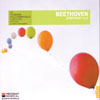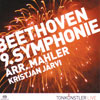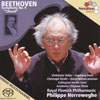Beethoven arr Mahler Symphony No 9, 'Choral'
Three different approaches to Beethoven’s Ninth Symphony
View record and artist detailsRecord and Artist Details
Genre:
Orchestral
Label: Naïve
Magazine Review Date: 7/2010
Media Format: CD or Download
Media Runtime: 0
Mastering:
Stereo
DDD
Catalogue Number: V5202

Genre:
Orchestral
Label: Preiser
Magazine Review Date: 7/2010
Media Format: CD or Download
Media Runtime: 0
Mastering:
Stereo
Catalogue Number: PR90773

Genre:
Orchestral
Label: Pentatone
Magazine Review Date: 7/2010
Media Format: Super Audio CD
Media Runtime: 61
Mastering:
Stereo
DDD
Catalogue Number: PTC5186317

Author: Richard Osborne
Mahler’s performance scores of the Ninth have long been extant. In 1966 William Steinberg made a recording of the Ninth which drew on some of these Retuschen (“retouchings”). More recently David Pickett produced a critical edition based on the score Mahler himself marked up for his first Vienna performance in February 1900 and the orchestral parts he had drawn up by professional copyists. It is an edition that has been performed by Leonard Slatkin, Kristjan Järvi, Vasily Petrenko and Neeme Järvi. Mahler’s changes to the Ninth did not so much address the problems as exacerbate them. His defence of the changes was disingenuous: “There can be absolutely no question of re-orchestration, alteration, let alone ‘improvement’ of Beethoven’s work” [his italics]. Yet this is a version that deploys eight horns and four trumpets, reinforcements which often require him to alter the pitch of the existing wind lines to accommodate them. Bar 93 of the Scherzo, a famous crux where for decades the gentle insinuation of a pair of horns was thought sufficient, is treated by Mahler to two trumpets and a battery of horns (Järvi, 1'53"-2'04"). C’est magnifique, Monsieur Mahler, mais ce n’est pas Beethoven! It could have been worse. In Hamburg in 1895, he experimented with an offstage band in the finale.
Järvi’s performance provides us with the aural facts of the Mahler Retuschen but little else. Mahler’s orchestra would not have sounded or been seated like this and Järvi’s conducting – foot-on-the-accelerator, characteristic of our metronome-obsessed age – is far removed from anything Mahler (or Beethoven) might have contemplated. Richard Strauss’s phrase about Mahler’s retouchings being “coarse” albeit “well-intentioned” could well be applied to this Tonkünstler performance. The vocal work in the finale is not for the squeamish.
In his Cambridge Handbook Professor Cook argues that the Ninth Symphony is de facto a work of the Romantic repertory; that latter-day attempts to restore it to the Classical period are, in effect, “an attempt to appropriate it for the late 20th century, in disguise”. This may go some way to explaining why there is a depressing predictability and narrowness of vision about many more recent recordings of the Ninth, performances which are over-driven and drained of the all-important element of song which underpins even this micro-managed score.
Philippe Herreweghe’s Ninth is not untypical. The first movement, taken at speed, is light on any form of expressive nuance. Similarly, the slow movement is played quite rapidly, driven by an implausible metronome mark which plainly contradicts the written marking Adagio molto e cantabile. The finale is expertly realised, the very opposite of what used to happen with old-style, big-numbers Ninths. Yet when one hears the exquisite legato shading of the sopranos’ cadential “aus Elysium” 24 bars before the symphony’s end, one is bound to ask why expressive freedom is granted to singers while being denied elsewhere in the symphony to instrumentalists, the strings in particular.
Herreweghe’s orchestra plays on modern instruments. Emmanuel Krivine’s “project-based” La Chambre Philharmonique is an ad hoc period instrument ensemble. Theirs is a pugnacious, rather crudely delineated account of the symphony which has been recorded in close-up in similarly pugnacious sound during a series of live performances in two separate venues. The lack of refinement in the ensemble playing is most noticeable in the Adagio (again rapidly played) where the inner parts chatter and clunk. Nor is there compensating joy in the finale where Krivine shows scant regard for the needs of his singers. Overdriven and occasionally poorly tuned, this account of the finale is not in the same league as Herreweghe’s.
Discover the world's largest classical music catalogue with Presto Music.

Gramophone Digital Club
- Digital Edition
- Digital Archive
- Reviews Database
- Full website access
From £8.75 / month
Subscribe
Gramophone Full Club
- Print Edition
- Digital Edition
- Digital Archive
- Reviews Database
- Full website access
From £11.00 / month
Subscribe
If you are a library, university or other organisation that would be interested in an institutional subscription to Gramophone please click here for further information.




